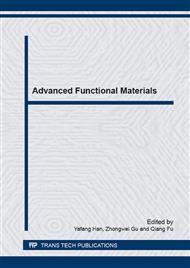[1]
L.L. Hench, R.J. Splinter, W.C. Allen, T.K. Greenlee, Bonding mechanisms at the interface of ceramic prosthetic materials. J. Biomed. Mater. Res. 2(1972)117-141.
DOI: 10.1002/jbm.820050611
Google Scholar
[2]
O. Peitl, E.D. Zanotto, L.L. Hench, Highly bioactive P2O5–Na2O–CaO–SiO2 glass-ceramics. J Non-Cryst. Solids 292(2001)115-126.
DOI: 10.1016/s0022-3093(01)00822-5
Google Scholar
[3]
I.D. Xynos, M. V.J. Hukkanen, J. J. Batten, L. D. Buttery, L.L. Hench, J.M. Polak, Bioglass ®45S5 stimulates osteoblast turnover and enhances bone formation in vitro: implications and applications for bone tissue engineering. Calcif. Tissue Int. 67(2000).
DOI: 10.1007/s002230001134
Google Scholar
[4]
S. Levy, M. Van Dalen, S. Agonafer, W.O. Soboyejo, Cell/surface interactions and adhesion on bioactive glass 45S5. J. Mater. Sci: Mater. Med. 18(2007)89-102.
DOI: 10.1007/s10856-006-0666-9
Google Scholar
[5]
Q.Z. Chen, I.D. Thompson, A.R. Boccaccini, 45S5 Bioglass®-derived glass–ceramic scaffolds for bone tissue engineering. Biomaterials 27(2006)2414-2425.
DOI: 10.1016/j.biomaterials.2005.11.025
Google Scholar
[6]
D.F. Williams, Implants in dental and maxillofacial surgery. Biomaterials 2(1981)133-146.
Google Scholar
[7]
H. Yli-Urpo, M. Närhi, T. Närhi, Compound changes and tooth mineralization effects of glass ionomer cements containing bioactive glass (S53P4), an in vivo study. Biomaterials 26(2005)5934-5941.
DOI: 10.1016/j.biomaterials.2005.03.008
Google Scholar
[8]
D.G. Gillam, J.Y. Tang, N.J. Mordan, H.N. Newman, The effects of a novel bioglass dentifrice on dentine sensitivity: a scanning electron microscopy investigation. J. Oral Rehabil. 29(2002)305-313.
DOI: 10.1046/j.1365-2842.2002.00824.x
Google Scholar
[9]
B.S. Lee, C.W. Chang, W.P. Chen, W.H. Lan, C.P. Lin, In vitro study of dentin hypersensitivity treated by Nd: YAP laser and bioglass. Dent. Mater. 21(2005)511-519.
DOI: 10.1016/j.dental.2004.08.002
Google Scholar
[10]
Z.H. Dong, J. Chang, Y. Zhou, K.L. Lin, In vitro remineralization of human dental enamel by bioactive glasses. J. Mater. Sci. 46(2011)1591-1596.
DOI: 10.1007/s10853-010-4968-4
Google Scholar
[11]
M.E. Donna, A.P. Lisa, Nanoindentation of biological materials. Nanotaday 1(2006)26-33.
Google Scholar
[12]
L. Lefebvre, J. Chevalier, L. Gremillard, R. Zenati, G. Thollet, D. Bernache-Assolant, A. Govin, Structural transformations of bioactive glass 45S5 with thermal treatments. Acta Materialia 55(2007)3305-3313.
DOI: 10.1016/j.actamat.2007.01.029
Google Scholar
[13]
B.T. Amaechi, S.M. Higham, In vitro remineralisation of eroded enamel lesions by saliva. J. Dent. 29(2001)371-376.
DOI: 10.1016/s0300-5712(01)00026-4
Google Scholar
[14]
W.C. Oliver, G.M. Pharr, An improved technique for determining hardness and elastic modulus using load and displacement sensing indentation experiments. J. Mater. Res. 7(1992)1564-1583.
DOI: 10.1557/jmr.1992.1564
Google Scholar
[15]
E. Donnelly, S.P. Baker, A.L. Boskey, C.H. Marjolein, van der Meulen, Effects of surface roughness and maximum load on the mechanical properties of cancellous bone measured by nanoindentation. J. Biomed. Mater. Res. A 77(2006)426-435.
DOI: 10.1002/jbm.a.30633
Google Scholar
[16]
S.S. Saeed, A.G. Kārlis, Micromechanical properties of single crystal hydroxyapatite by nanoindentation. Acta Biomaterialia 5(2009)2206-2212.
DOI: 10.1016/j.actbio.2009.02.009
Google Scholar
[17]
I. Manika, J. Maniks, Size effects in micro- and nanoscale indentation. Acta Mater. 54(2006)2049-(2056).
DOI: 10.1016/j.actamat.2005.12.031
Google Scholar


